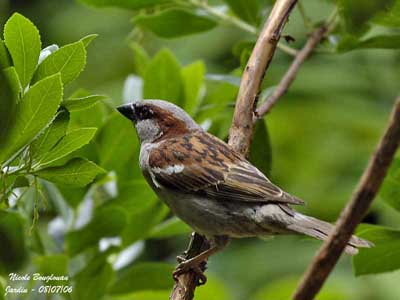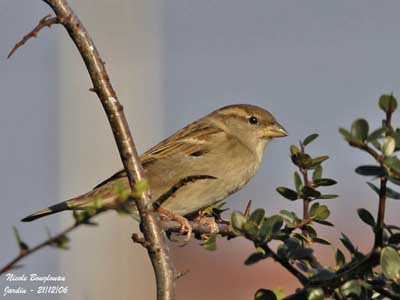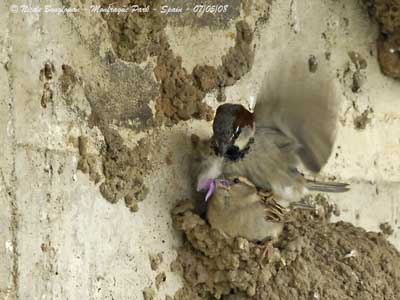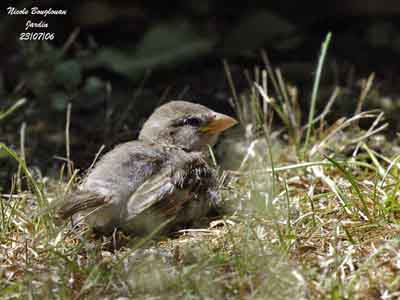
House Sparrow
Passer domesticus
Passeriforme Order - Passeridae Family
BIOMETRICS:
Length: 14-16 cm; Wingspan: 19-25 cm; Weight: 25-32 g
LONGEVITY : 13 years
DESCRIPTION:
It is a stocky bird with strong black bill and pinkish legs.

The adult male has dark chestnut upperparts with black streaks on back and scapulars. On the upperwing, we can see a conspicuous white wing bar. The flight feathers are brown and edged with darker brown. The tail is dark brown and the rump is greyish. The pale greyish underparts strongly contrast with black chin and bib.
On the head, the grey crown and the nape are bordered with reddish-chestnut from the rear eye, through ear-coverts, and finishing on neck sides. Cheeks are greyish-white. The eyes are dark brown dark with black lores.
In winter plumage, the male shows duller, less extended bib, and a duller plumage, less reddish. The bill is paler too.

The female has a rather brown plumage streaked with black on the upperparts, and greyish below. We will note the lack of black bib, and the presence of a buffy-white eyebrow. The bill is yellowish. The crown is brown.
Juvenile resembles female.
VOICE: SOUNDS BY XENO-CANTO
The typical call of the House Sparrow is a strong “chii-ip”, but we can also hear a short and monotonous “chip”.
When it is excited, it utters short, repeated and fast sounds. When it flies, it gives a short “chwiiit”.
Its song is a series of chirp and repeated squealings.
HABITAT :
The house sparrow lives around habitations, from down town and urban zones to the more desert areas, cultivated fields and country. It is rarer in forest and usually from deserts.
RANGE:
The House Sparrow is present throughout the entire world, except in the Poles. Native of Eurasia and North Africa, it was introduced in South Africa, North and South Americas, Australia and New Zealand. In North America, one hundred birds were released in Brooklyn, New York, in 1851. They are now common and largely widespread in their habitat.
BEHAVIOUR:
The House Sparrow moves easily on the ground, by hopping quickly for feeding. It also catches insects in flight after active chasing. They feed in groups in order to be mutually protected from potential predators. It is rarely alone. Even in breeding season, this species remains gregarious. They also form important flocks in autumn and winter.
During the night, large flocks sleep in the high vegetation, in plants which climb on the walls, in trees or under roofs. The arrival at these roosts at dusk, and the departure at dawn are always very noisy.
The courtship displays are spectacular. Several males calls strongly while turning around one female, with open wings whose tips touch the ground, the bill pointed upwards and the tail fanned and raised in order to expose the grey rump. After a while, the female obliges them to disperse, by pecking them. The males then continue to utter excited calls and quarrel in branches, even in the absence of the female. The House Sparrows breed in colonies under the roofs or in the cavities of constructions.
PERSONAL OBSERVATION:
I was the unwitting and discrete witness of original courtship behaviour during the copulation. This fact occurred in Extremadura (Spain) in last May.

Under a bridge sheltering numerous swallow nests, a House Sparrow was perched on a broken nest, waiting quietly for something, with a white feather in the bill. I saw a female, arriving close to him, and receptive for mating.
I was very surprised when I saw a piece of violet flower (Spanish Lavender) in her bill, which she kept until the end of copulation.
Both copulate several times in a few minutes as sparrows do it. The male kept the white feather during the first copulations and left it before the end. On the other hand, the female kept the flower in the bill until the end!
If in some species, it is common to see the male offering petal of flower, twig or food to the female during the displays, this behaviour was unknown and apparently never observed in House Sparrows.
Could be the House Sparrow become romantic?
All the photographs about this scene: PHOTOGRAPHIC RAMBLE
FLIGHT:
House Sparrow has fast and direct flight, more undulating when flying higher. It may fly at varied speeds, as for pursuing insects or moving from perch to perch.
REPRODUCTION:
The House Sparrow nests in crevices, holes or cavities in or on the constructions, under the roofs or in holes in trees.
Both adults build the nest with dry grasses, feathers, strings and bits of paper. Breeding usually starts in May.
Female lays 3 to 5 greyish-white eggs with dark grey and purplish spots. But colours may vary according to each female.
Incubation starts with the last egg laid, and lasts about 10 to 14 days, mainly by female. But the male may brood during several minutes, when the female is feeding.

Chicks are altricial, and fed by both parents by regurgitation of insects. Youngs leave the nest at about two weeks of age, and become independent at 26 to 28 days.
This species may produce four broods per year, but usually three.
DIET:
The House Sparrow feeds on various seeds, insects and larvae, but it also consumes fruits, earth worms and spiders.
In urban areas, it may find anything and take advantage of all opportunities for feeding.
PROTECTION / THREATS / STATUS:
The House Sparrow is threatened by birds of prey, but also by cats and dogs, raccoons and snakes according to the part of the world where it lives.
Because they are abundant close to habitations, they became a nuisance, involving competition with the native birds of the areas where they were introduced, and they also are pest crops.
This species remains common and largely widespread in its range. However, declines have been observed since a few years, not very well understood at this moment, but unfortunately noticed in several places, and more particularly in the United Kingdom, but also in some other European countries.
Fr: Moineau domestique
All : Haussperling
Esp : Gorrión Doméstico
Ital: Passera europea
Nd: Huismus
Russe: Воробей домовой
Sd: Gråsparv
Text and photographs by Nicole Bouglouan
Sources :
THE HANDBOOK OF BIRD IDENTIFICATION FOR EUROPE AND THE WESTERN PALEARCTIQUE by Mark Beaman, Steve Madge - C.Helm -ISBN: 0713639601
THE COMPLETE BOOK OF BRITISH BIRDS – Préface de Magnus Magnusson – Editeurs: Michael Cady- Rob Hume - ISBN: 0749509112
Animal Diversity Web (University of Michigan Museum of Zoology)
Wikipedia (Wikipedia, The Free Encyclopaedia)